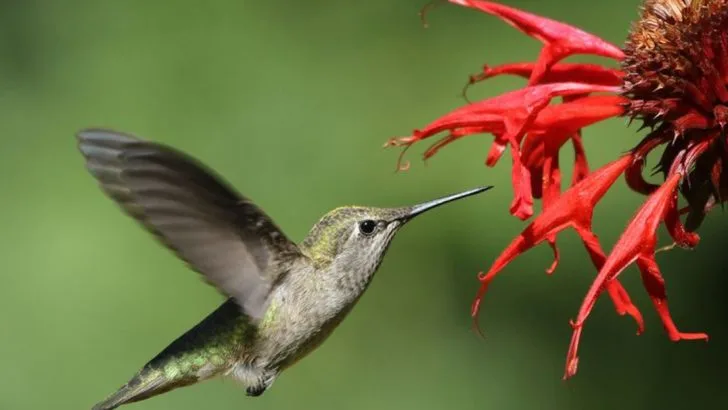Hummingbirds are drawn to vibrant, nectar-rich flowers, and the right plant choices can turn your summer garden into their favorite stop. These tiny pollinators aren’t just beautiful to watch—they play a crucial role in your garden’s ecosystem. By planting the right flowers now, you’ll create a haven that keeps them coming back all season long.
Color, shape, and bloom time all matter when attracting hummingbirds. Bright reds, oranges, and pinks naturally catch their eye, while tubular flowers provide the perfect shape for their long beaks. Selecting a mix of early, mid, and late-blooming varieties ensures that your garden stays full of nectar through the hottest months.
From classic favorites to lesser-known blooms, these 23 flowers will guarantee a summer garden that’s buzzing with hummingbird activity.
Bee Balm
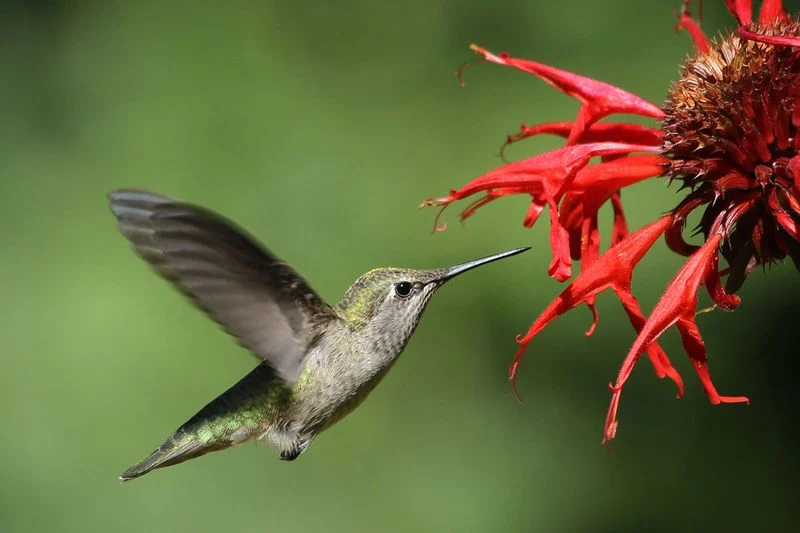
With its bright red, tubular petals, Bee Balm offers an irresistible treat for hummingbirds. Known for its ability to thrive in sunny gardens, this flower attracts not just birds but also beneficial pollinators. Plant it in clusters to make a bold statement in your garden. Bee Balm’s aromatic foliage adds an extra sensory experience. Consider its role in herbal remedies as a delightful bonus. Regular watering will ensure it blooms continuously throughout the summer. This perennial returns year after year, making it a sustainable choice for hummingbird enthusiasts seeking reliability.
Salvia
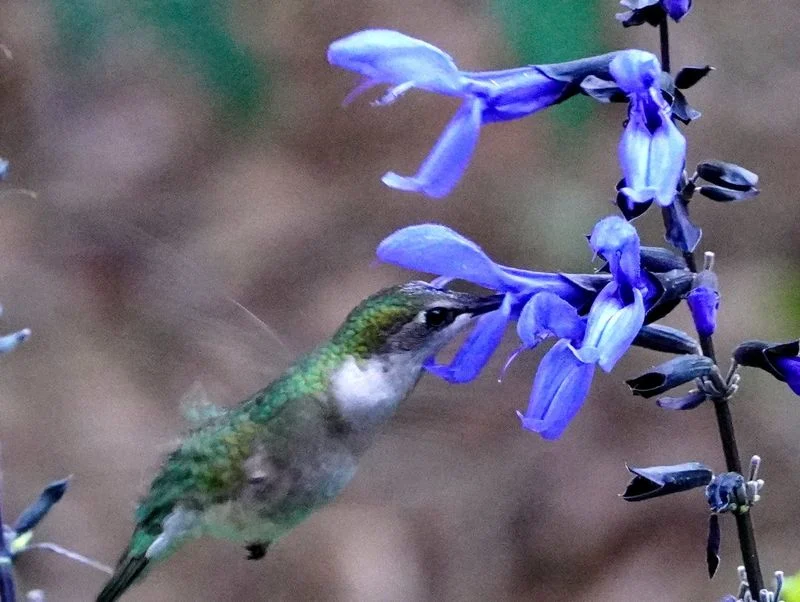
A favorite among hummingbirds, Salvia’s slender stalks are adorned with clusters of tubular flowers. Its deep blue or purple hues make it a striking addition to any garden. This drought-tolerant plant thrives in well-drained soil. Salvia’s ability to withstand high temperatures makes it ideal for hot climates. Plant it in groups for the best visual impact. Prune regularly to encourage new blooms. Its long flowering season ensures that your garden remains a hummingbird haven from spring through fall. This versatile plant is also known for its medicinal properties.
Columbine
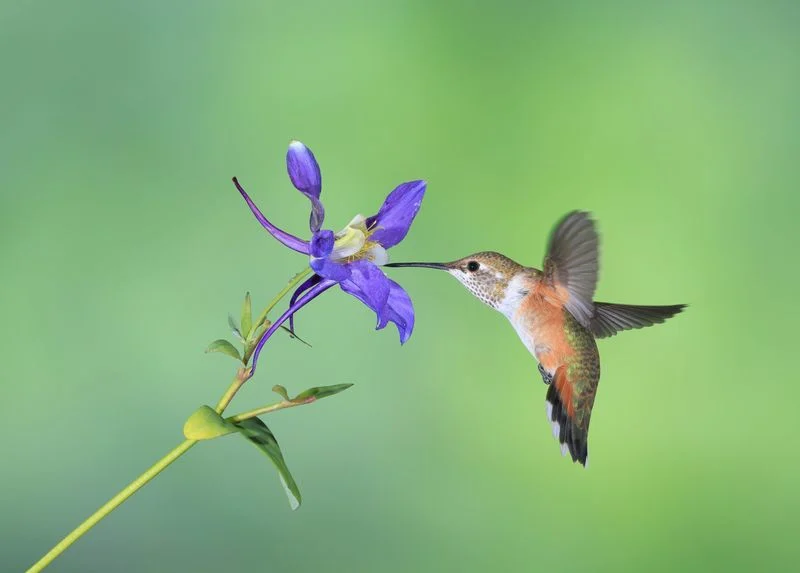
The delicate beauty of Columbine flowers is captivating, featuring intricate petals in a variety of colors. These flowers thrive in partial shade, making them perfect for woodland settings. Columbine’s unique shape is particularly appealing to hummingbirds, who enjoy sipping nectar from its spurred petals. This perennial is also known for attracting bees and butterflies, enhancing garden biodiversity. Deadheading spent flowers encourages further blooming. With its ability to self-seed, Columbine can naturally spread, offering a dynamic and ever-evolving garden display.
Trumpet Vine
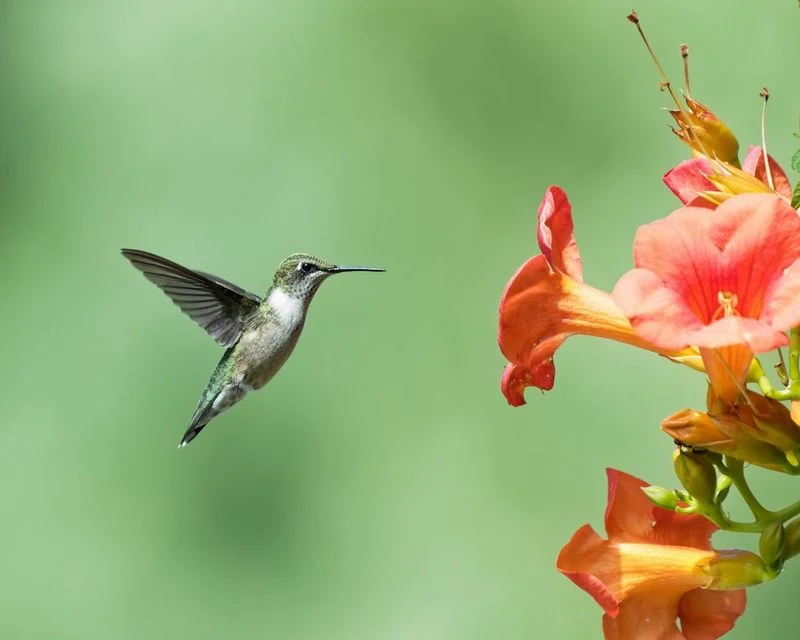
Known for its vigorous growth, Trumpet Vine produces bright orange, trumpet-shaped flowers that are a hummingbird favorite. Its climbing nature makes it ideal for trellises and fences. Trumpet Vine can grow aggressively, so regular pruning is necessary to control its spread. Its flowers not only provide nectar but also add a tropical touch to your garden. Plant in full sun for maximum blooms. This hardy plant can withstand a variety of soil conditions, making it a versatile choice for different garden environments.
Fuchsia
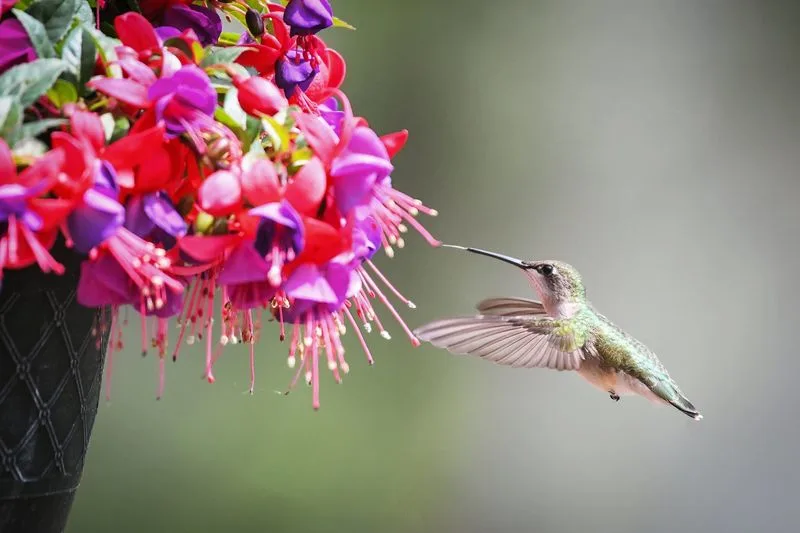
Fuchsia’s striking pink and purple blooms add a unique charm to any garden space. These flowers thrive in shady spots, making them perfect for hanging baskets on a porch. Hummingbirds are particularly drawn to their downward-facing blooms. Regular watering and fertilizing will keep Fuchsia blooming all season long. It’s important to protect them from harsh sun to prevent wilting. This tender perennial can be overwintered indoors in colder climates, ensuring their vibrant display returns year after year. Fuchsia also offers a cascading visual effect when planted in elevated containers.
Coral Bells
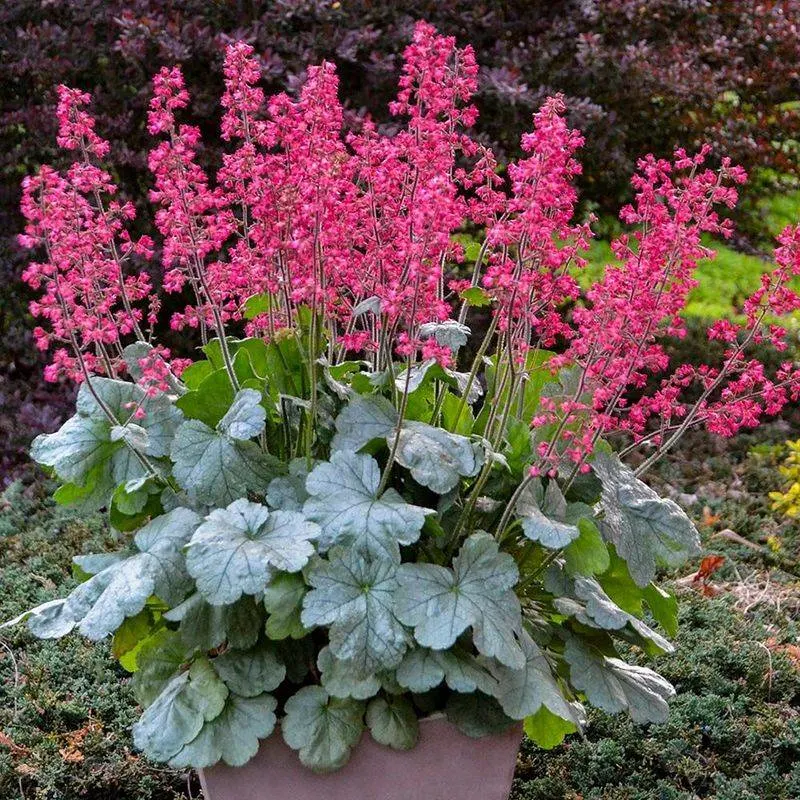
Featuring striking foliage and delicate bell-shaped flowers, Coral Bells are a dual attraction for both hummingbirds and garden enthusiasts. Their red leaves provide a colorful contrast against the flowers. Ideal for shaded areas, they can also thrive in partial sun. These perennials require minimal maintenance, making them perfect for busy gardeners. Regular deadheading will promote prolonged blooming. Coral Bells also serve as excellent ground cover, preventing soil erosion and maintaining garden aesthetics. They can be paired with other shade-loving plants for a cohesive garden look.
Penstemon
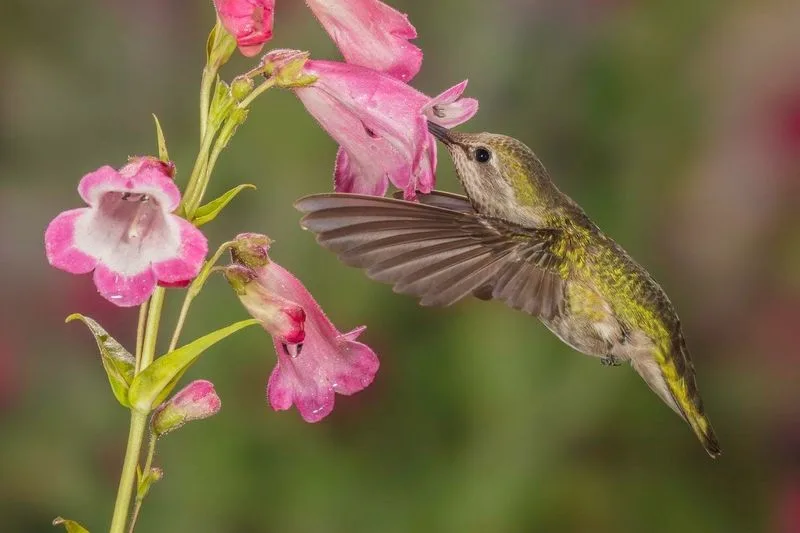
Penstemon’s tubular flowers are designed for hummingbird beaks, offering easy access to their nectar. Available in a variety of colors, including pink and purple, Penstemon adds diversity to your garden palette. These flowers prefer full sun and well-drained soil, thriving even in rocky areas. Penstemon is drought-resistant, making it suitable for xeriscaping. Regular pruning will encourage a bushier growth. Its long blooming period ensures hummingbirds have a consistent food source. Additionally, Penstemon’s attractive foliage adds texture to garden borders, enhancing visual interest.
Lantana

Lantana’s clusters of tiny flowers create a kaleidoscope of colors that are irresistible to hummingbirds. This hardy plant thrives in hot and dry conditions, making it ideal for sunny spots. Lantana’s ability to bloom continuously throughout the summer keeps your garden lively. Its resilience to pests and diseases means less maintenance for gardeners. However, in some regions, it can become invasive, so monitoring its spread is crucial. Lantana’s fragrant foliage also attracts butterflies, enhancing the garden’s biodiversity. A favorite for container gardens, it provides versatile design options.
Hibiscus
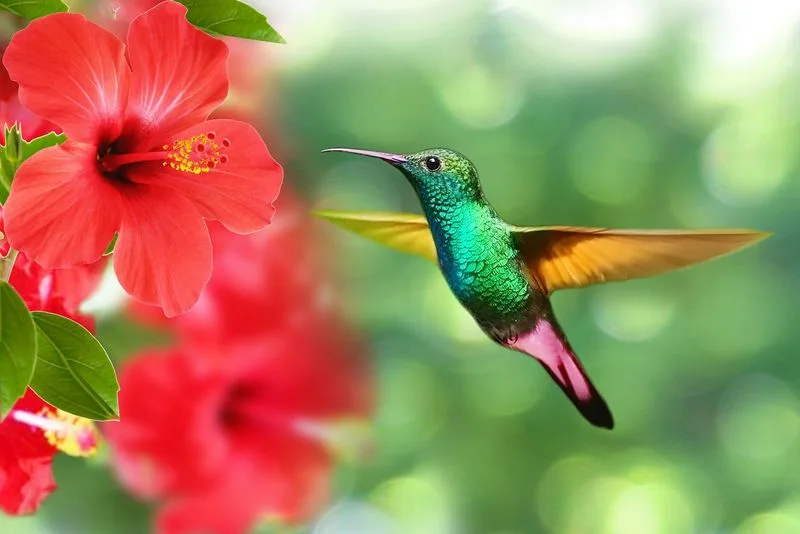
Hibiscus flowers, with their large, bold petals, are an iconic choice for attracting hummingbirds. These tropical beauties flourish in warm climates and love full sun. Hibiscus requires regular watering to maintain its lush blooms. Its vibrant colors range from red to pink to white, offering versatile garden aesthetics. While it thrives outdoors in summer, it can be brought indoors during colder months. Hibiscus also has cultural significance in many regions, celebrated for its beauty and symbolism. Pruning encourages more blooms, ensuring your garden remains a hummingbird hotspot.
Cardinal Flower
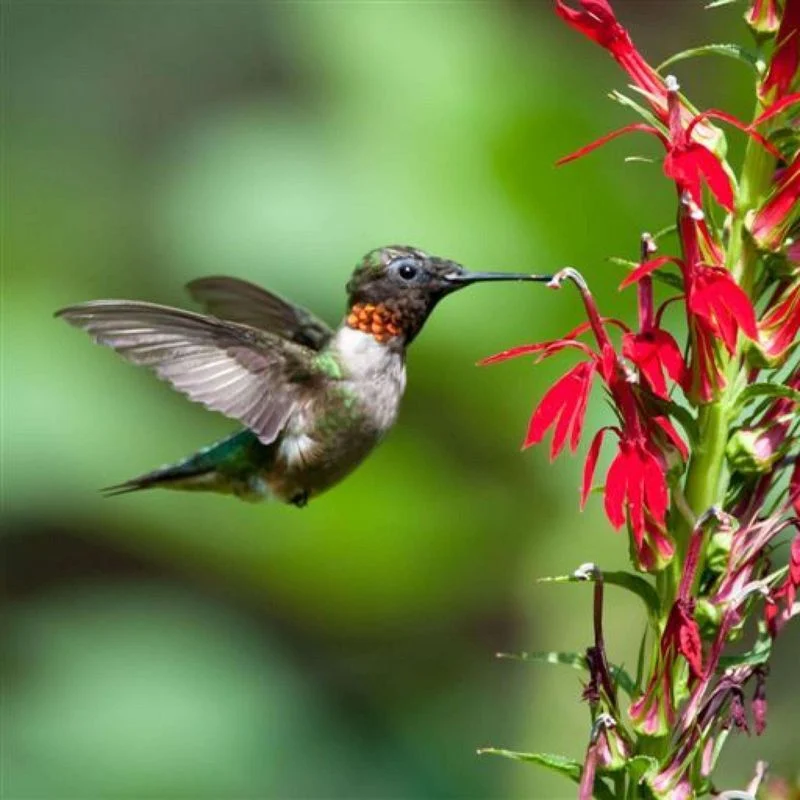
The vivid red blooms of the Cardinal Flower are as stunning as they are effective at attracting hummingbirds. This moisture-loving plant thrives in wetland areas, making it perfect for gardens with water features. Cardinal Flower prefers partial shade and rich, well-drained soil. Its tall stalks add height to garden beds, creating dynamic layers in your landscape. As a native plant, it supports local ecosystems. Regular mulching will retain soil moisture, promoting healthy growth. Despite its delicate appearance, it’s quite hardy and will return year after year with proper care.
Petunia
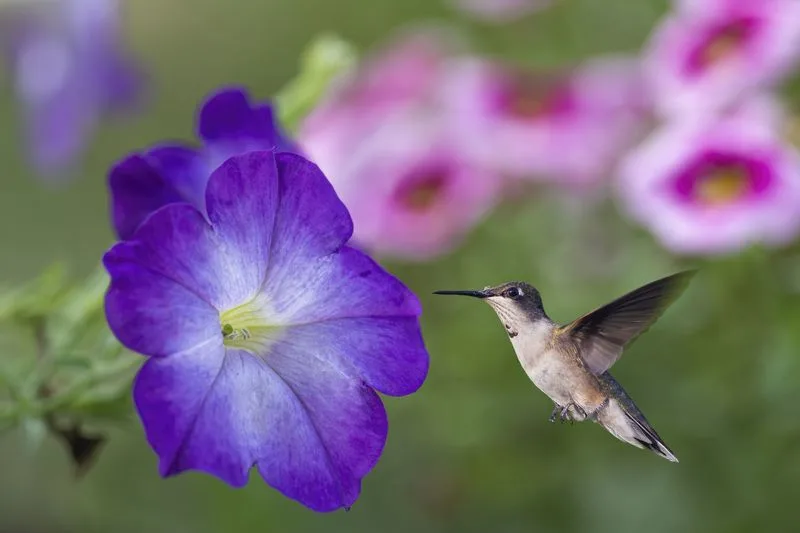
Petunias, with their vibrant hues, are a staple in hummingbird gardens. These annuals thrive in sunny locations and are perfect for adding a splash of color to hanging baskets and window boxes. Regular deadheading encourages continuous flowering, keeping your garden lively. Petunias are versatile, available in many colors including pink, purple, and white. They require regular watering, especially in containers, to prevent wilting. Known for their resilience, petunias can endure a range of weather conditions. Their sweet fragrance also attracts other pollinators, supporting a healthy garden ecosystem.
Zinnia
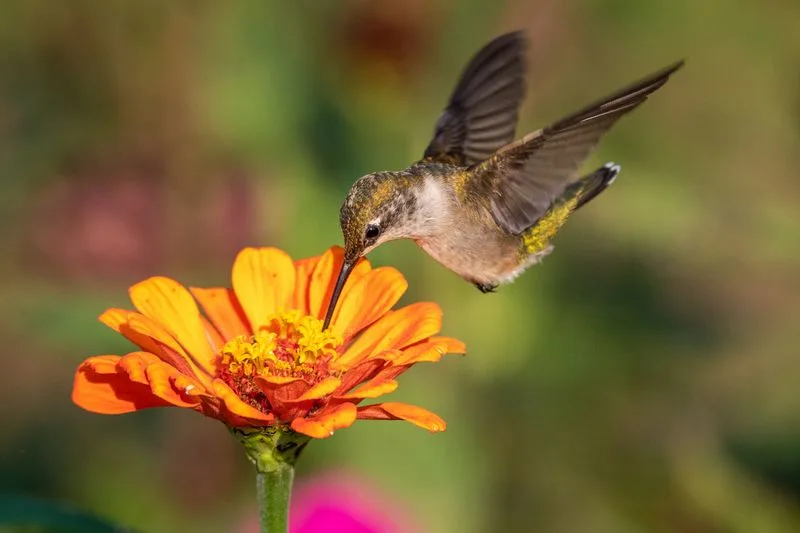
Zinnias are a garden favorite, offering large, bright blooms in a range of colors. These annuals attract hummingbirds with their open petals and accessible nectar. Zinnias thrive in full sun and need well-drained soil to flourish. Regular watering and deadheading will extend their blooming season. They are also resistant to pests and diseases, making them a low-maintenance choice. Zinnias’ robust nature allows them to withstand heat, ensuring vibrant displays even in mid-summer. Their ability to attract bees adds to the garden’s pollinator population, enriching biodiversity.
Foxglove
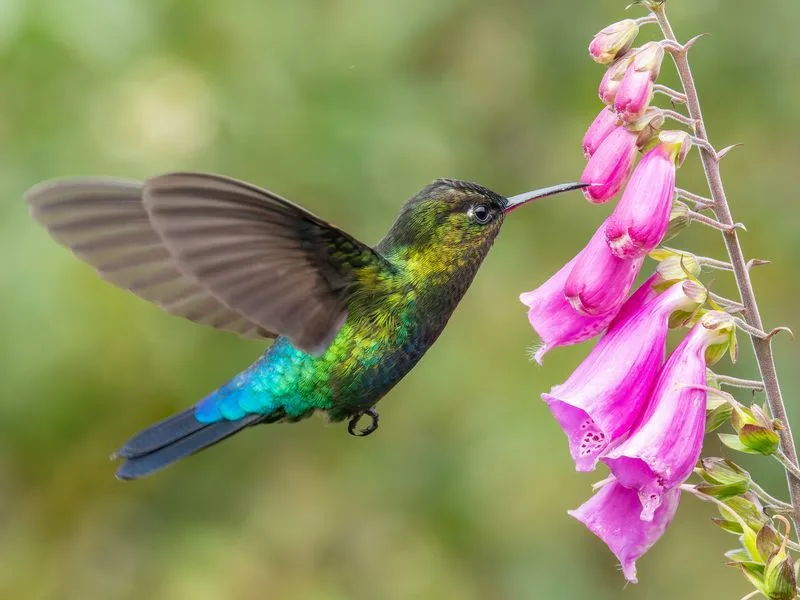
Standing tall with spikes of bell-shaped flowers, Foxglove is an enchanting addition to any garden. Its purple blooms are particularly attractive to hummingbirds. Foxglove thrives in partial shade and moist, well-drained soil. While it requires careful handling due to its toxic properties, its beauty is unmatched. Foxglove’s vertical growth adds a dramatic element to garden designs. Deadheading the flowers will encourage repeat blooming. Often used in cottage garden settings, Foxglove can be paired with other shade-loving plants for a cohesive look. Remember to wear gloves when handling.
Honeysuckle

Honeysuckle vines attract hummingbirds with their fragrant, tubular blossoms. Ideal for covering fences or creating natural boundaries, they thrive in full sun or partial shade. Honeysuckle requires regular pruning to keep its growth in check and to encourage more blooms. This hardy plant is drought-tolerant once established, making it suitable for less fertile areas. Its sweet scent not only attracts birds but also provides a pleasant aroma for garden visitors. Honeysuckle can become invasive, so planting it in containers or controlling its spread is advisable. It’s a versatile addition to any garden.
Snapdragon
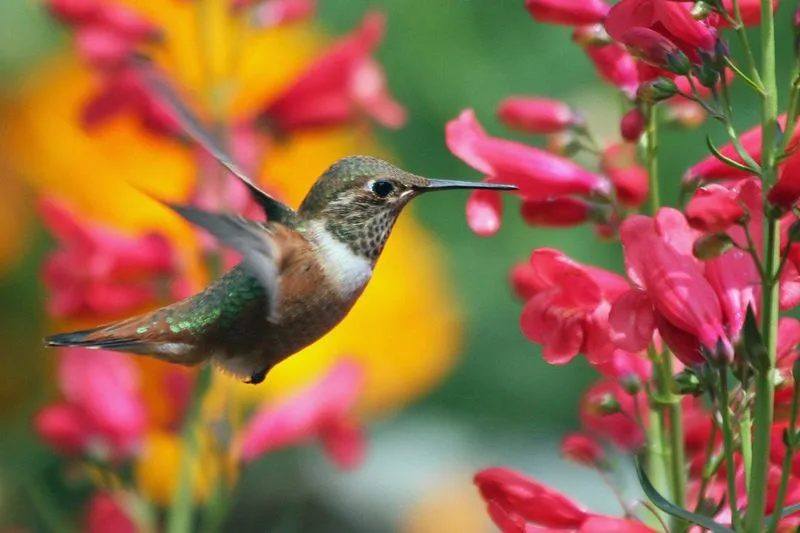
Snapdragons offer a delightful burst of color with their tall, thick stalks and varied hues. These flowers are a hit with hummingbirds due to their uniquely shaped blooms. Snapdragons prefer cooler weather but enjoy full sun, making them perfect for spring and fall gardening. Regular deadheading will promote prolonged flowering. While they are typically grown as annuals, in milder climates they can return year after year. Snapdragons add vertical interest to garden beds and borders, creating a lively and dynamic landscape. Their resilience to pests makes them easy to maintain.
Butterfly Bush
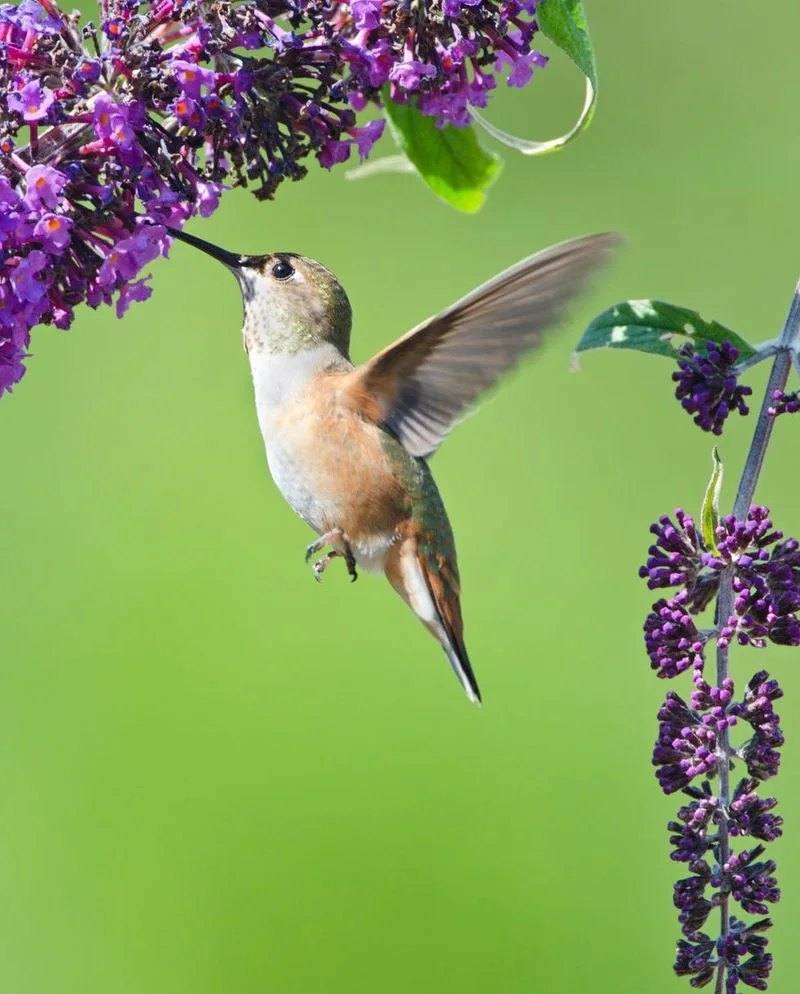
The Butterfly Bush, true to its name, draws not only butterflies but also hummingbirds with its sweet nectar. Its long, arching branches are covered in clusters of purple or pink flowers. This shrub thrives in full sun and is drought-tolerant once established. Pruning in early spring encourages vigorous growth and abundant blooms. Butterfly Bushes are perfect for creating borders or as a standalone feature in gardens. Despite its invasiveness in some regions, it remains a popular choice for its beauty and attraction to pollinators. Regular monitoring will help control its spread.
Agastache
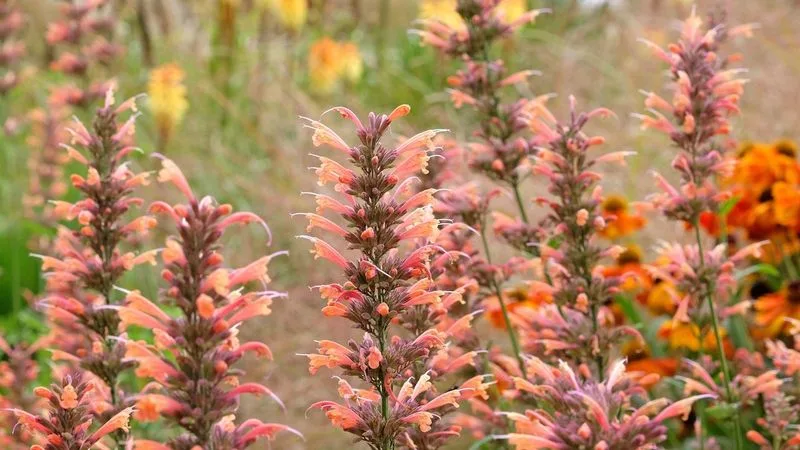
Agastache, often known as hyssop, is prized for its aromatic foliage and lavender-hued flowers. These tall plants are particularly inviting to hummingbirds. Agastache thrives in sunny locations and well-drained soil, making it ideal for xeriscaping. Its drought-tolerant nature means it requires minimal watering once established. Regular pruning will maintain its shape and encourage more blooms. Agastache is also resistant to deer and rabbits, reducing common garden pest issues. Its long flowering season extends from summer into early fall, offering a prolonged attraction for hummingbirds. A perfect blend of form and function.
Cosmos

Cosmos flowers offer a whimsical touch with their delicate, daisy-like blooms. These annuals are easy to grow and thrive in full sun. Cosmos are drought-tolerant, making them perfect for gardeners seeking low-maintenance options. They attract hummingbirds with their open, nectar-rich flowers. Regular deadheading will keep them blooming all season. Cosmos add a soft, airy texture to garden borders and meadows. Their ability to self-seed means they can return year after year, creating a naturalized look. Pair them with other sun-loving plants for a harmonious garden display.
Bleeding Heart
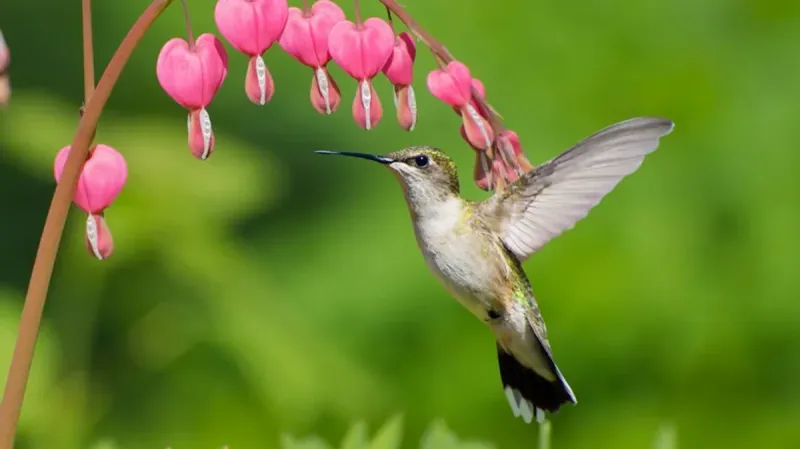
Bleeding Heart plants, with their signature heart-shaped flowers, bring a touch of romance to shaded gardens. These perennials thrive in cool, moist environments. Hummingbirds are drawn to their pendulous blooms, which dangle elegantly from arching stems. Bleeding Hearts require minimal maintenance, making them ideal for secluded garden areas. Ensure the soil remains consistently moist for optimal growth. Their delicate appearance belies their resilience, as they return faithfully each spring. Bleeding Hearts pair well with other shade-loving perennials, creating a serene and enchanting garden retreat.
Red Hot Poker
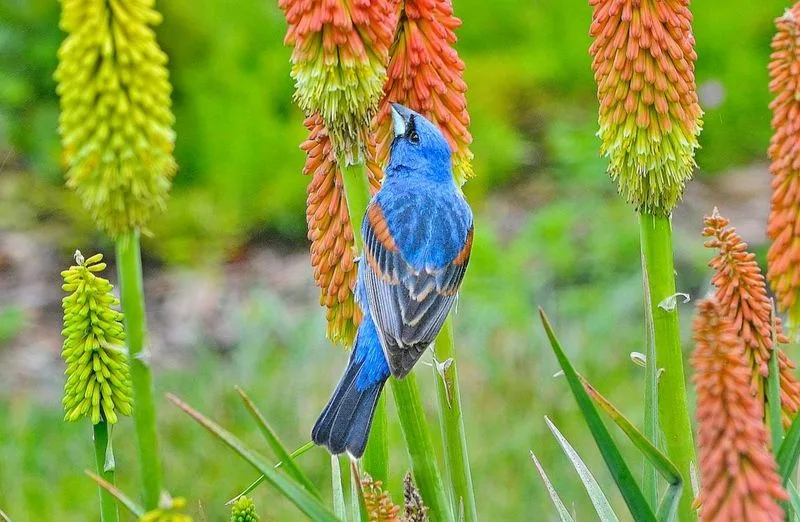
Red Hot Poker plants stand out with their tall, architectural spikes of fiery orange and yellow flowers. These perennials thrive in full sun and well-drained soil. Their striking appearance makes them a focal point in any garden. Hummingbirds are particularly attracted to their tubular flowers. Red Hot Pokers require minimal maintenance, though deadheading spent blooms will encourage new growth. These plants are drought-tolerant once established, making them suitable for arid environments. Their unique form and vibrant color are perfect for creating dramatic garden displays.
Canna Lily
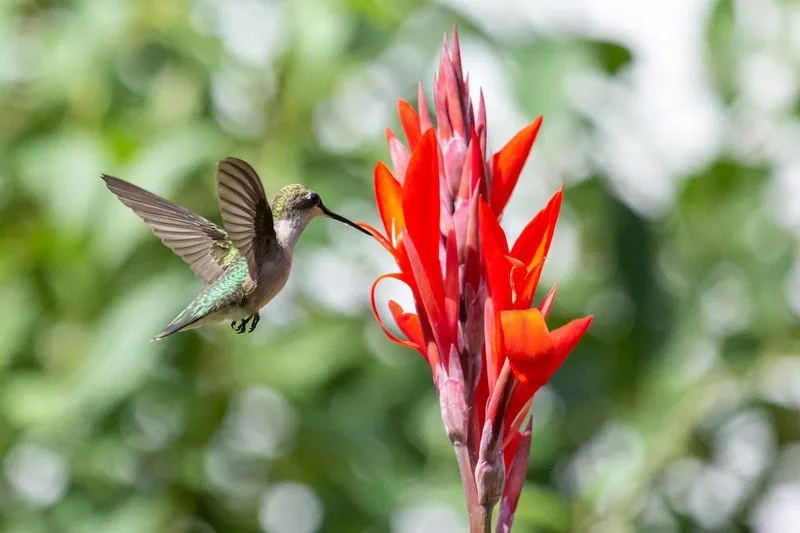
Canna Lilies offer a tropical flair with their large, bold blooms and lush foliage. These perennials thrive in warm climates with plenty of sunlight. Hummingbirds are drawn to the vivid red flowers, which provide ample nectar. Canna Lilies require regular watering to keep their foliage healthy. Their tall stature adds vertical interest to garden beds. In colder regions, bulbs can be lifted and stored indoors during winter. Canna Lilies also make excellent container plants, offering versatility in garden design. Their dramatic presence is sure to captivate both birds and gardeners alike.
Cleome
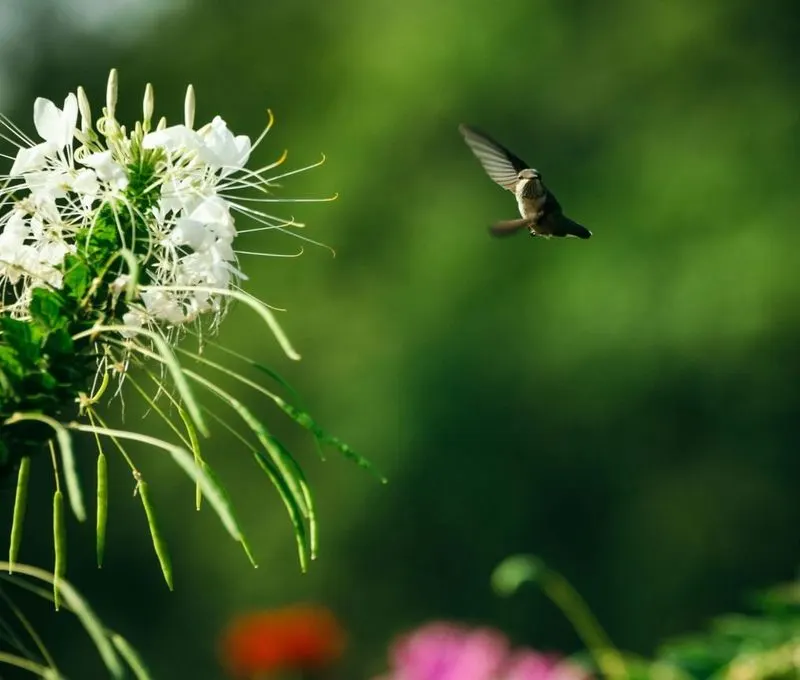
Cleome, often known as spider flower, delights with its tall stalks and spider-like blooms. These annuals are easy to grow, thriving in full sun and well-drained soil. Hummingbirds find their open, nectar-rich flowers irresistible. Cleome’s unique appearance adds an exotic touch to garden borders. Regular deadheading will prolong their blooming season. While they can self-seed, they are not invasive, ensuring they complement garden landscapes without taking over. Cleome offers both beauty and biodiversity, drawing in pollinators and providing visual interest throughout the summer months.
Electric Blue Passionflower
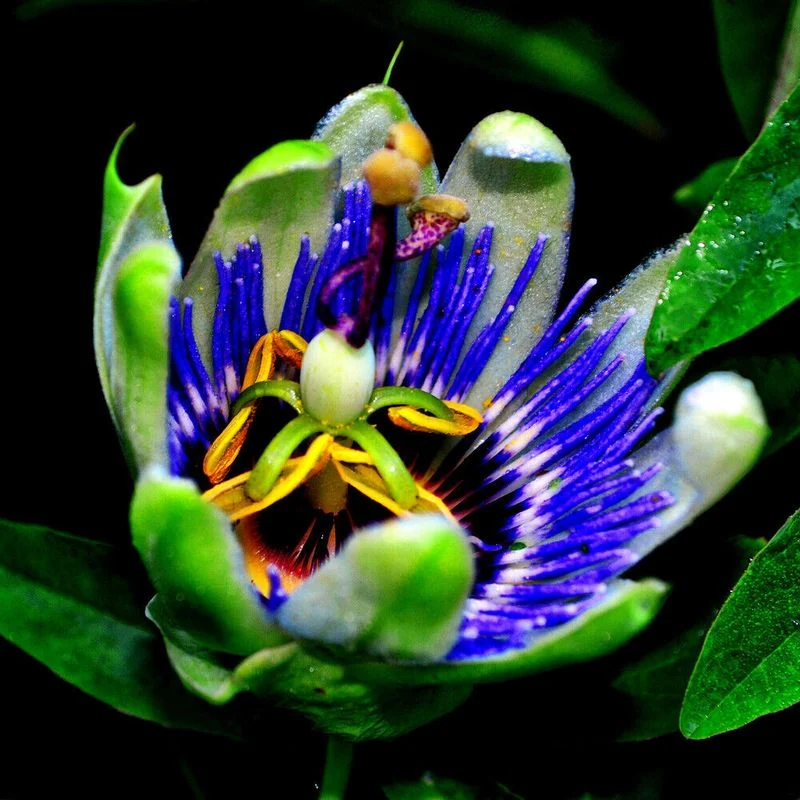
The Electric Blue Passionflower is a spectacular addition to any hummingbird garden. This exotic flower boasts striking electric blue petals that create a visual feast for the eyes. Its intricate patterns and vibrant colors are not just a treat for humans but a beacon for hummingbirds.
This passionflower’s unique appearance makes it a standout choice for gardeners looking to break away from the ordinary. Plant it in a sunny spot and watch as it becomes a focal point in your garden.
Beyond its beauty, the Electric Blue Passionflower offers a sweet nectar that hummingbirds find irresistible, ensuring your garden is buzzing with life.

